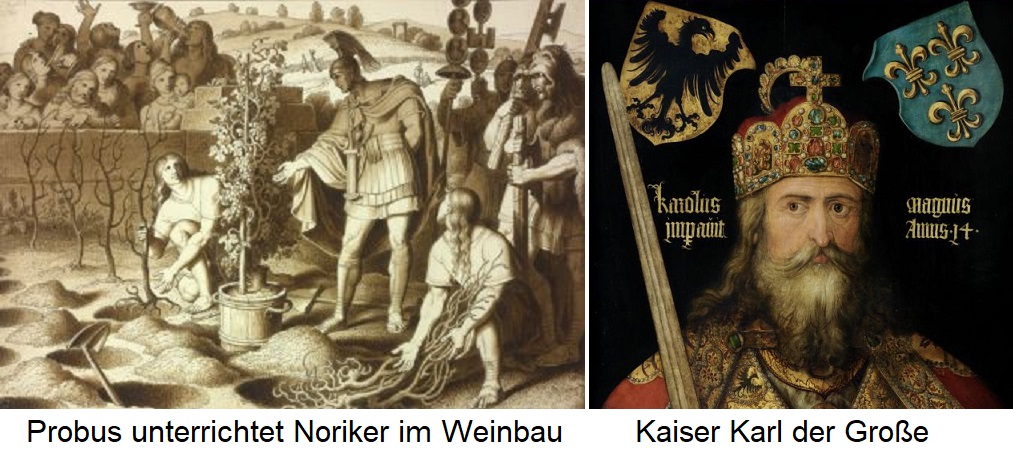Wine quality level (IGP); see under France.
France
The Republic of France with its capital Paris covers 632,734 km². It is an intercontinental state in Western Europe with overseas territories. The national territory is located on all continents with the exception of Asia. The European part of the national territory (France métropolitaine) covers 543,940 km² (85%) and borders Spain and Andorra to the south-west, Belgium, Luxembourg, Germany, Switzerland and Italy to the north and east, and Monaco to the south-east. The island of Corsica (8,760 km²) is a French territorial entity with special status. It is much closer to Italy than France.

The overseas territories outside the heartland are known as "Départements et régions d'outre-mer" (DOM) and cover 88,794 km² (roughly the same as Austria). They are former French colonies. These are Guadeloupe and Martinique (island groups in the Caribbean), French Guiana (in the north of South America on the Atlantic Ocean between Brazil and Suriname), Réunion (island in the Indian Ocean) and Mayotte (island north-west of Madagascar).
The country is administratively divided into 23 regions with a total of 101 departments (96 of which are in Europe). Understandably, there is only significant viticulture in the European area. The wine-growing areas are distributed fairly evenly over three quarters of the surface area, especially along the many bodies of water (see below).
History
Compared to Greece and Italy, France is a relatively young wine-growing country. The first vines were introduced in the 6th century BC by the Greeks, who founded Massalia (lat. Massillia = Marseille) in the south-west on the Mediterranean coast. At this time, the land later called Gaul by the Romans was inhabited by various Celtic tribes (Allobroges, Ambians, Arvernes, Biturians, Cenomanians and others in France, Norics in Bavaria and Austria).
A lively trade developed and the Greeks met the demand. When they immigrated to the Po Valley in the 5th century, they learnt about Italian wine and began to import it. The French had therefore been consuming wine for a long time before they began to cultivate it themselves on a large scale. The conquest of Gaul by Julius Caesar (100-44 BC) led to the systematic spread of wine in the Rhône valley in the 1st century, in Burgundy and Bordeaux in the 2nd century and in the Loire in the 3rd century. The Roman Emperor Marcus Aurelius Probus (232-282) lifted the ban imposed by Emperor Domitian (51-96) and ordered the planting of vines throughout Gaul in the middle of the 3rd century.

Charlemagne
The King of the Franks and later Emperor Charlemagne (742-814) gave decisive impetus to viticulture in present-day France through his decrees. The Catholic order of Cistercians was founded in the monastery of Cîteaux in Burgundy in 1098 and quickly spread throughout Europe. The monks perfected viticulture in terms of soil type selection, grape variety selection and winemaking, which had an impact throughout Europe. However, the Benedictine order, whose most famous member was probably Dom Pierre Pérignon (1638-1715), the "inventor" of assemblage, the skilful blending of wines, made an equally significant contribution to viticulture. It is also worth mentioning that wine was included in the French revolutionary calendar, and September was given the name Vendèmiaire (wine month).
Bordeaux classification
The famous Bordeaux classification took place in 1855. This had a major influence on the later quality class systems, which vary greatly from region to region. Shortly afterwards, the country was the starting point of the greatest and most comprehensive disaster in the history of viticulture, when phylloxera and powdery and downy mildew began their campaign of destruction across Europe from the 1860s onwards. France was particularly badly affected, with over three-fifths (700,000 hectares) of its vineyards destroyed. At the same time, however, the "Golden Years of Bordeaux" signalled a new beginning when vineyards were planted on a large scale in the Médoc.
The concept of terroir
In France, it was recognised early on that a wine with unmistakable characteristics is produced on a specific soil, under the influence of the local microclimate and specially selected grape varieties. The Cistercians laid the foundations as early as the Middle Ages. The term terroir was coined in the first third of the 20th century. In the 1920s, vineyard owner Pierre Le Roy de Boiseaumarié (1890-1967) described the ideal grape varieties for Châteauneuf-du-Pape based on the typical soil and climate in an area he defined. Further impetus came from Joseph Capus (1868-1947), who together with Boiseaumarié is considered the initiator of the appellation system.
Wine-growing regions
France was the first country to geographically map its wine-growing regions. This was done by defining legally valid areas and boundaries from which the specific quality of a wine can be clearly derived. This is clearly and unmistakably defined by the appellation in question. The better the wine, the more precise the regulations and, as a rule, the smaller the area. The special system of "controlled origin" is described under Appellation d'Origine Protégée; it is controlled by the INAO authority. The wine-growing areas are mainly located along the many rivers such as the Dordogne, Garonne, Gironde, Loire and Rhône, as well as their numerous tributaries. Under the protection and supervision of the INAO, there are around 400 AOP areas(quality wines) and around 100 IGP areas(regional wines). In contrast to Italy (where this is 100% identical), there is hardly any correspondence between the wine-growing regions and the...
Voices of our members

wein.plus is a handy, efficient guide to a quick overview of the colourful world of wines, winegrowers and grape varieties. In Wine lexicon, the most comprehensive of its kind in the world, you will find around 26,000 keywords on the subject of grape varieties, wineries, wine-growing regions and much more.
Roman Horvath MW
Domäne Wachau (Wachau)